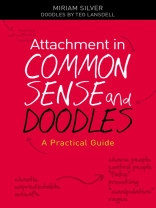Attachment is a word used to describe a simple idea – the relationship with someone you love or whose opinions are important to you – so why is so much of the language relating to attachment so obscure, and why is it so challenging to help children who lack healthy attachment bonds?
Attachment in Common Sense and Doodles aims to bring some clarity and simplicity to the subject. Providing grounded information and advice accompanied by a series of simple ‘doodles’ throughout, it explains attachment in language that is easy to understand and describes how to apply this information in everyday life. It describes how the attachment patterns in children who are adopted or fostered differ, summarises the latest research in the field and provides advice on how to repair attachment difficulties and to build secure, loving relationships.
Covering all of the ‘need to know’ issues including how to spot attachment difficulties, build resilience and empathy and responding to problematic behaviour, this book will be an invaluable resource for families and professionals caring for children who are fostered, adopted or who have experienced early trauma.
Table of Content
Acknowledgements. Foreword by Camila Batmanghelidjh. Preface. 1.What is Attachment and Why Does it Matter? 2. Can Attachment Patterns Change? 3. What is ‘Good Enough’ Care, and What Does it Do? 4. Shaping Behaviour. 5. Effects of Parenting on the Infant’s Brain. 6. Through the Generations. 7. Changing Patterns – The Tug of War of Attachment. 8. Arousal Revisited. 9. The Calm and the Storm. 10. Diagnoses. 11. Understanding Thoughts, Feelings and Behaviours. 12. Parenting with PACE. 13. Layers. 14. Shame and Changing the Norm. 15. Roles and Belonging. 16. Stories. 17. Time Holes and Triggers. 18. Patterns That Suck Us In. 19. Heroes. Appendix 1: The Impact of Poor Early Care. Appendix 2: Additional Reading. References. Index.
About the author
Dr Miriam Silver is a Consultant Clinical Psychologist who specialises in parenting, attachment issues and the impact of early trauma. She has led a Child and Adolescent Mental Health Services team providing services for looked after and adopted children as well as conducting court expert witness work in Care proceedings. She holds two academic posts and has conducted research in risk and resilience factors in adoptive matching and the development, mental health and wellbeing of children who no longer live with their biological family. For several years she was chair of the national network of Clinical Psychologists working with Looked After and Adopted Children within the British Psychological Society.












